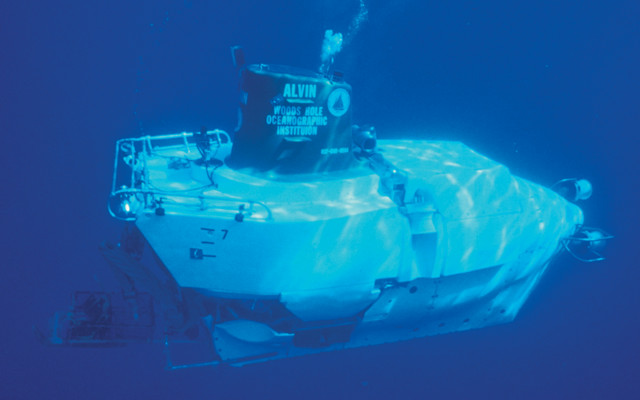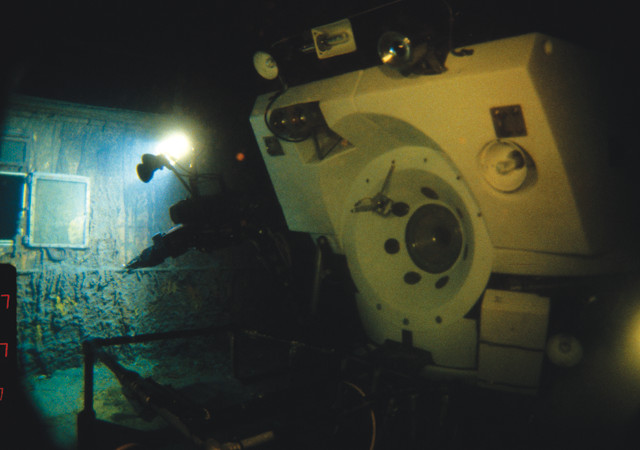
by Carolyn Gramling Tuesday, January 27, 2015

The Alvin. Credits: Woods Hole Oceanographic Institution.
Every oceanographer knows Alvin. Since 1964, the legendary deep submergence vehicle has carried more than 12,000 scientists and other observers to the bottom of the ocean on more than 4,600 dives. Its exploits are legion: locating and recovering a lost U.S. hydrogen bomb in 780 meters of water off the coast of Spain in 1966, exploring the first-known hydrothermal vents (black smokers off the Galapagos Islands) in 1977 and surveying the wreck of the Titanic in 1986.
The U.S. Navy-owned Alvin is the oldest continuously active research submersible in the world — and as such, it has received plenty of upgrades over the years: a new robotic arm here, a replaced valve there. By 2010, in fact, every valve, wire, filter and circuit from the original vehicle had been replaced. But an even more ambitious upgrade is in store: Beginning this year, Alvin will undergo an extensive overhaul that will ultimately put 98 percent of the ocean floor within its reach.
The overhaul — financed by the National Science Foundation — will happen in two stages, says Kurt Uetz, the project manager for the Alvin upgrades at the Woods Hole Oceanographic Institution (WHOI) in Massachusetts. In the first stage, just getting under way, Alvin will receive upgrades designed to withstand these deeper descents: new lighting and imaging systems, new syntactic foam (buoyant and yet strong enough to be a sturdy structural material at depth), an improved command and control system — and a new, larger personnel sphere with an ergonomically designed interior. Ergonomic design, Uetz notes, is no small consideration to three people (a pilot and two scientists) crammed into a circular room the size of a large station wagon for as much as 12 hours.
Alvin will also get a couple of new eyes: two extra portholes, in addition to the existing three, that will give its passengers more opportunity to study the underwater world.
The second stage, Uetz says, will include more upgrades to the back end of the submarine, in order to bring the entire sub to a 6,500-meter dive rating. That stage, he says, will get started in about five years, and will include developing a safe lithium-ion battery to improve energy efficiency, as well as a new ballasting system and new thrusters. “We did it in two stages because the total cost to replace the whole vehicle to [rate it] to 6,500 meters was pretty steep,” Uetz says. “The sphere was the highest-priced component, so we’re doing that first.”
Currently, Alvin is completely disassembled — a rare moment of downtime for the peripatetic submersible — and awaiting its facelift, the first stage of which people can watch live via a webcam at www.whoi.edu/home/alvinCam/. EARTH’s Carolyn Gramling “chatted” with Alvin — courtesy of Uetz and Alvin Expedition Leader Bruce Strickrott, also at WHOI — about what’s in store.
CG: So where exactly are you right now?
A: Spread all over the place in the High Bay, a large hangar at the Woods Hole Oceanographic Institution’s Iselin Marine Facility in Massachusetts.
CG: You’ve had many upgrades over the years. Do you have any of your original parts from 1964?
A: I don’t think so. Most of my oldest components date from about the 1970s, but there is one piece that could be original, and is quite likely the oldest piece. It’s a flat surface right next to the hatch opening [on the personnel sphere], a landing when you climb inside.
My original sphere, which was commissioned in 1964, was actually made out of steel. I could dive to about 2,000 meters. But in 1973 I got a new, stronger titanium alloy sphere, as part of Project Titanus [the beginning of the search for the Titanic], so that I could dive deeper, to about 4,000 meters. The steel sphere is now in the Navy Museum in Washington, D.C.
CG: Your new personnel sphere is intended to be more ergonomic. Was the previous personnel sphere really that uncomfortable?
A: Yes, so I’m told. The pilot’s seat used to be just an aluminum box with a pad on top. When it became clear we were going to get the money for the upgrades, we solicited numerous users to get their opinions. The scientists had a lot to do with the redesign. And also with the extra viewports — that was driven by scientists.

Alvin on the deck of the Titanic in 1986, with light shining on the ship's bulkhead porthole. Cameras on the ROV Jason Jr. took the photo. Credit: Woods Hole Oceanographic Institution.
CG: So now you’ll have five instead of three windows?
A: Actually, I always had five windows. In addition to the three in front, there was a small one in the hatch and one on the bottom that we cover up. When I was first conceived, there was a call for proposals to decide what I would look like. The winning design [by engineer Harold Froehlich] had a beam of light coming out of the bottom window. They thought it would be useful for driving around. They figured out that we don’t use those windows though, so we don’t need them.
CG: Why are more viewing windows important?
A: I used to just be an observational vehicle — I didn’t have any arms. There was one forward-looking window, for the pilot, and two on the sides for the scientists. Then, over the years, they added arms and thrusters — there was a lot more going on up front, and the scientists weren’t easily able to see what the pilot was seeing. Now, for example, instead of just pointing out their window and hoping the pilot picks up the right rock, the scientists can watch as the pilot does it.
I remember one dive where Strickrott was the pilot. We parked in front of a large, 40-meter-tall tubeworm pillar, an amazing structure. You could see it out the front window, but not out of the side windows, so Strickrott would get out of the pilot’s seat to let the scientists have a look. There’s always a huge “wow” factor when the scientists can actually see these structures; the workload for them is so intense, they often look out the front for no more than a few minutes at a time. I’m really looking forward to bringing people down. The new windows, which are also significantly larger, will open up the field of view for the scientists, and expand the spatial sense of what they’re looking at, making it more of a shared experience.
CG: Right now you can reach 63 percent of the ocean floor. The new upgrades will put a lot more of the ocean floor within your reach. Where will you and won’t you be able to go?
A: The current sphere is good for 4,500 meters. The new one will be 6,500 meters — that’s 98 percent of the ocean floor. I won’t be able to get into the trenches. But going deeper isn’t just to reach the bottom; I can also work in much deeper waters.
It really comes down to the batteries. They’re my fuel. The pilots are trained to include a large reserve factor for safety. Safety first. I swim very safely — I don’t operate under cables, don’t dive into caves. I’m afraid of the dark. And I don’t run out of juice.
CG: What other improvements are happening in the first phase of the upgrade?
A: One big improvement is that my payload is doubling to 400 pounds. That doesn’t sound like a lot, but when I’m underwater and operating normally, I’m essentially weightless — neutrally buoyant. But if I start picking up a lot of rocks to carry back to the surface, they have to make me lighter to compensate.
CG: When do you get back in the water?
A: I’ll be back in operation in the summer of 2012, after stage one is complete.
CG: How many other deep manned submersibles are out there?
A: There are about half a dozen or so of us. But — not to brag — the number of dives I’ve made is probably about equal to the rest of them put together. I’m really a workhorse. The Chinese are in the testing phase of a sub that will go to about 7,000 meters. The Russians have two subs rated to 6,000 meters. The Japanese have Shinkai, which is rated to 6,500 meters. That’s currently the deepest-diving submersible. And the French have Nautile, which is rated to 6,000 meters.
Those are the deepest. But they’re all a little younger than me. I’m an old man.
© 2008-2021. All rights reserved. Any copying, redistribution or retransmission of any of the contents of this service without the expressed written permission of the American Geosciences Institute is expressly prohibited. Click here for all copyright requests.